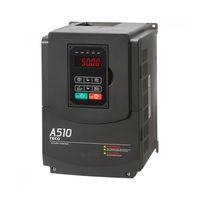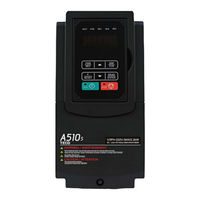TECO A510s Manuals
Manuals and User Guides for TECO A510s. We have 5 TECO A510s manuals available for free PDF download: Instruction Manual, Quick Setting Manual, Manual
TECO A510s Instruction Manual (520 pages)
A510s series
Table of Contents
-
Preface6
-
-
Installation17
-
-
-
-
LCD Keypad89
-
-
Main Menu91
-
Monitor Mode92
-
-
Parameters96
-
PID Parameters130
-
Control Mode135
-
-
2-Wire Operation165
-
Keypad Control165
-
3-Wire Operation166
-
PLC Control167
-
Pulse Input169
-
Conveyor181
-
Exhaust Fan181
-
Hvac181
-
Compressor181
-
Main Screen189
-
Main Menu189
-
SLV or SV Mode198
-
Motor Slip205
-
External Fault219
-
Sync Command221
-
DC Braking221
-
Timing Function221
-
EPS Function223
-
During Running230
-
Frequency Agree230
-
Pulse Input Gain241
-
Pulse Input Bias241
-
Bias Adjustment253
-
Jump Frequency 4257
-
Fault Reset Time272
-
Coast to Stop277
-
PID Control Mode303
-
Feedback Gain303
-
PID Adjustments304
-
Gain Control304
-
Integral Control304
-
PID Control Type305
-
PID Tuning308
-
PID Fine Tuning309
-
PID Unit314
-
OVP Operation323
-
KEB Operation328
-
Zero-Servo Gain328
-
Zero-Servo Count329
-
Parameters Lock337
-
C/B CPLD Ver.339
-
PG Card ID339
-
PG Card Ver.339
-
PLC Parameters340
-
Display Unit342
-
Engineering Unit342
-
LCD Backlight344
-
Auto-Tuning349
-
FOC Delay Time353
-
FOC Gain353
-
SLV Control Mode362
-
Speed Limit Bias373
-
Torque Control374
-
PM Encoder Type387
-
PM Motor Tuning387
-
Basic Command396
-
-
Timer Function401
-
-
Parameter Data420
-
-
Specifications431
-
-
Wiring432
-
-
GSD File440
-
-
-
-
Emergency Stop461
-
-
AC Line Reactors491
-
Other Options504
-
-
-
UL Standards512
-
Advertisement
TECO A510s Instruction Manual (674 pages)
Table of Contents
-
-
Preface8
-
-
Environment18
-
Installation19
-
-
Section 2
478-
ASCII Mode483
-
Exception Code483
-
Function483
-
Stx483
-
End484
-
Exception Code484
-
LRC Check484
-
RTU Mode484
-
02H485
-
Introduction661
-
TECO A510s Manual (107 pages)
Brand: TECO
|
Category: Controller
|
Size: 3 MB
Table of Contents
Advertisement
Advertisement




